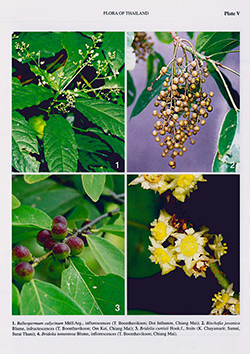e-Flora of Thailand
Volume 8 > Part 1 > Year 2005 > Page 151 > Euphorbiaceae > Bridelia
10. Bridelia tomentosa Blumewfo-0000428079
Bijdr.: 597. 1826; Baill., Étude Euphorb.: 584. 1858; Müll.Arg. in DC., Prodr. 15(2): 501. 1866; Kurz, Forest Fl. Burma 2: 367. 1877; Hook.f., Fl. Brit. Ind. 5: 271. 1887; Craib, Bull. Misc. Inform. Kew 1911: 457. 1911; Jabl. in Engl., Pflanzenr. IV. 147. viii: 58, fig. 11A. 1915; Airy Shaw, Kew Bull. 26: 231: 1972; Whitmore, Tree Fl. Malaya 2: 74. 1973; Airy Shaw, Kew Bull. Add. Ser. 4: 65. 1975; Dressler, Blumea 41: 297, fig. 2, map 6; Dressler & Welzen in Welzen et al., Thai Forest Bull., Bot. 28: 67. 2000. Plate V: 4.
Accepted Name : This is currently accepted.
Synonyms & Citations :
Description : Scrambling to erect shrub to tree, up to 13 m high; branchlets glabrous to tomentose, lenticels scattered; old branches sometimes thorny. Stipules narrowly triangular to ovate, 2–4(–5) by ca 1 mm, apex sometimes aristate, glabrous to tomentose, early caducous. Leaves: petiole 2–5.5 mm long, glabrous to tomentose; blade elliptic to obovate, 2.5–14 by 1–6 cm, length/width ratio (1.7–)2–3.7, papery to thinly chartaceous, pilose to villose above, tomentose beneath (Thailand), base obtuse (to acute), margin entire to somewhat crenate, apex (bluntly) acute (to acuminate); venation (weakly) prominent on both sides, neres 7–12(–15) pairs, joining marginal vein, tertiary veins irregularly scalariform. Inflorescences glomerules in axils of normal leaves, with up to 10(–20) sessile flowers. Flowers green; staminate ones 2–3 mm in diam., pistillate ones 3–4 mm in diam.; pedicel 0(–1) mm long; sepals triangular 0.8–1.5 by 0.5–1.2 mm, glabrous, petals variable in shape, up to 1 by 0.8 mm, base cuneate to spathulate, apex roundish, notched or lobulate; staminal column ca 0.7 mm long; free part of filaments up to 0.5 mm long; anthers shortly ellipsoid, 0.4–0.5 by 0.3–0.4 mm; ovary globose, ca 1 inm in diam.; styles 2, completely free, together with stigmas 0.5 mm long; stigmas bifid. Fruits up to 7 per glomerule, (sub)globose, sometimes depressed and laterally compressed, emarginate at apex, slightly bilobate, 4.5–6.5 mm in diam., 2-locular, blackish; endocarp 2, ca 4 by 5 by 2.5 mm, brown. Seeds semigloboid to broadly semi-tear-shaped, with deep lateral furrow, 3–3.5 by ca 4 by 2–2.5 mm, brown.
Thailand : NORTHERN: Chiang Mai, Chiang Rai, Lampang, Phrae, Phitsanulok, Nakhon Sawan; NORTH-EASTERN: Loei, Nakhon Phanom, Khon Kaen; EASTERN: Chaiyaphum, Nakhon Ratchasima, Surin, Ubon Ratchathani; CENTRAL: Saraburi, Nonthaburi; SOUTH-EASTERN: Sa Kaeo, Chon Buri, Chanthaburi; SOUTH-WESTERN: Kanchanaburi, Prachuap Khiri Khan; PENINSULAR: Ranong, Surat Thani, Phangnga, Phuket, Nakhon Si Thammarat, Trang, Songkhla, Yala, Narathiwat.
Distribution : From E India, E Nepal and Sikkim lo S China and Taiwan, throughout SE Asia and Malesia (Borneo only SE corner, Java – type) up to N Australia.
Ecology : Deciduous to evergreen forests, primary to secondary vegetation, cominon on waste land and in secondary forests; on sandy or loany soil, limestone, granite bedrock; sea level up to 1,000 m alt. Flowers visited by butterflies.
Vernacular : Krabue (กระบือ), si fan krabue (สีฟันกระบือ)(Phitsanulok); lo-ko (โล่โก๊ะ)(Suai-Surin); sa lao (สะเหล่า)(Nakhon Ratchasima); la-ai (ละไอ)(Southwestern); sam phan ta (สามพันตา)(Ratchaburi); ma kae (มะแก)(Chon Buri); men true (เมนตรือ)(Southeastern); ka-ai (กะไอ), kue fung (กือฟุง), ma fang (มาฟาง)(Peninsular); ai (ไอ), khon non (ขนหนอน)(Nakhon Si Thammarat); kue-nung (กือนุง)(Malay-Narathiwat).
Uses: Timber tree, wood suitable for baskets, carts, wheels, and tool handles. The bark produces tannin and is, therefore, used for tanning, and colouring wood black. The bark, though astringent, and the leaves (as infusion) are used against colic in Java. The fruits are eaten and the seeds are used by children as bullets in bamboo guns. Well known in village medicine and folk tales.

